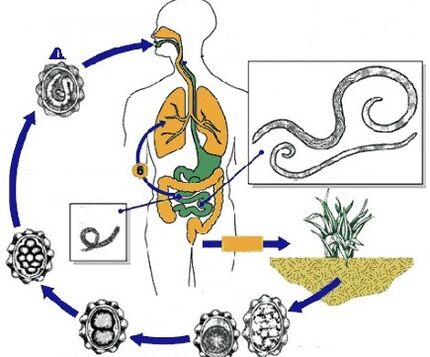
Helminthiases is a group of advanced parasitic diseases caused by the penetration of various parasitic worms into the body. These diseases are not limited to gender and age. It is worth noting that helminthiasis is more commonly diagnosed in children. The reason is that the child is unhygienic, eats food that has not been washed and often plays in a place with fresh air (sand pits, garden, etc. ).
Worms are a representative group of lower worms that can enter the human body and grow freely in it, thereby provoking the progression of parasitic diseases. All representatives of this group can be divided into 3 groups according to the conditions:
- roundworm
- ; tape
- ; flukes
- .
Depending on the mode of transmission, all types of human worms are divided into:
- biological helminth infection.In this case, the parasite is carried by an animal;
- is contagious.Infect from a patient;
- helminthiasis.This helminth is transmitted through the soil. This is due to the fact that a certain part of the parasite's life cycle occurs exactly in the ground.
Larvae and developing parasites are the most dangerous to the human body, as they can freely move around the body, infecting vital organs. The adult cannot move as freely and therefore has a more stable position.
Most worms "like" the parasites in the digestive tract. It is worth noting that different species are localized in different parts of the digestive tract: pinworms - in the lower part of the small intestine, roundworm - in its upper part, v. v. In addition, based on location, helminths are divided into tissues and cells.
It should be noted that the parasite can not only infect the gastrointestinal tract, but also infect the lungs, biliary tract and gallbladder itself. During life, they release many different toxic substances that poison the human body. It is important, if you suspect the presence of the parasite in the body, immediately consult a doctor and initiate treatment of the disease to avoid developing dangerous complications.
Symbol

Characteristic signs of helminthiasis appear primarily from the peripheral blood. If you do a clinical analysis, you may notice a significant increase in the number of eosinophils (especially during the acute phase of the disease). It should be noted that eosinophilia is often associated with severe leukocytosis.
Other signs of worms include:
- itching in the anus;
- can have unstable stools - alternating constipation and diarrhea;
- clenched her teeth while sleeping;
- Morning Sickness. Most often occurs in a person while brushing teeth;
- lose weight while the diet is unchanged;
- hyperthermia, accompanied by joint and muscle pain;
- drooling in the morning;
- a person who is constantly hungry;
- the appearance of rash elements on the skin (sometimes on the eyelids);
- The skin on your fingers may peel off.
Symptoms
The clinic of helminthiasis is divided into acute and chronic stages. The first symptoms of helminthiasis appear one month after the parasite enters the body. The acute phase of the pathological process begins. A person experiences the following symptoms:
- diarrhea;
- increased body temperature;
- inflamed upper respiratory tract;
- factors of the rash appear on the skin; conjunctivitis
- ;
- swelling of the face. This symptom is especially pronounced in children;
- young children sometimes develop tonsillitis and lymphadenitis.
The medical process can be complicated:
- hepatitis
- ; bronchospasm
- ;
- the appearance of infiltrates in the lungs; pneumonia
- ;
- meningitis; myocarditis
- .
The above symptoms do not coexist with any specific helminthiasis. Usually in the clinic of the disease, only two or three symptoms prevail. Such a clinical picture in a patient is observed for 7 days, after which the disease becomes chronic. The signs of the pathology vary depending on the type of parasitic pathogen in the human body:
- leukemia. Allergic reactions occur first. Allergic symptoms are at their peak. In the most severe clinical situations, even anaphylaxis may occur;
- filariasis and strongyloidiasis. The rash on the skin gets worse and the face becomes swollen.
Manifestations of helminthiasis also largely depend on the location of the parasite. Most of the parasites are in the digestive tract, leading to indigestion, weight loss, nausea, vomiting and intoxication syndrome.
Experts mention the most severe helminthiasis:
- leukemia;
- paragonimiasis;
- hydatid disease.
The specified types of helminths affect the most important organs and systems, so even with prompt treatment, the prognosis is often unfavorable.
Diagnosis
Due to the relatively large number of helminths, the diagnosis involves many research methods. The most information and frequently used are the following:
- integral analysis. In it, the doctor has a chance to detect helminth eggs, as well as undigested food debris, which indicates a disruption in the functioning of the gastrointestinal tract;
- blood on microfilariae;
- to detect roundworm and pinworm in human body, using macroscopic method;
- microscopic examination; bile research
- ;
- coproovoscopy endoscopy. Diagnosing helminthiasis by this method allows you to determine the intensity of the infestation of helminths;
- examine the contents of the duodenum;
- if the doctor suspects that a person is progressing trichinosis, a muscle tissue biopsy will be indicated; ultrasound
- ;
- x-ray;
- fibrinolytic endoscopy;
- tests the blood for the presence of antibodies that are specific to certain types of helminths.
Treatment
The main goal of treating the disease is to expel the parasite from the patient's body, as well as restore the normal functioning of the digestive tract. The treatment plan is ordered only by a qualified specialist after a thorough diagnosis and evaluation of test results. Treatment can be carried out both at the hospital and at home.
The basis of the treatment of helminthiasis is the use of specific helminthic agents.
The drug should only be taken as prescribed by the attending physician and according to the dosage prescribed by him. During the acute phase of the disease, a single dose of the drug is sufficient for the removal of the helminth. But often the treatment is carried out according to a certain plan.
During the treatment it is important to adhere to the following guidelines:
- strictly adheres to the rules of personal hygiene;
- diet therapy;
- all consumed products must be disposed of;
- where patients are being treated must regularly disinfect.
Treatment of helminthiasis in children is carried out only under static conditions, so that the doctor can continuously monitor the patient's condition and adjust the therapy if necessary. It is worth noting that the disease in children is more severe, so the course of treatment can be prolonged.
Precautions
Prevention of helminthiasis in children and adults should be exercised throughout life. Since helminths live underground and can also be transmitted by contact, you should pay attention to hygiene as much as possible - wash your hands, use personal hygiene items, etc. v. It is also important to prepare fruits and vegetables thoroughly before eating them.
For prophylaxis purposes, it is important to identify people infected with helminths promptly. For this purpose, surveys of certain adult groups are routinely carried out (especially those employed in the food sector, the medical sector, etc. ).






































